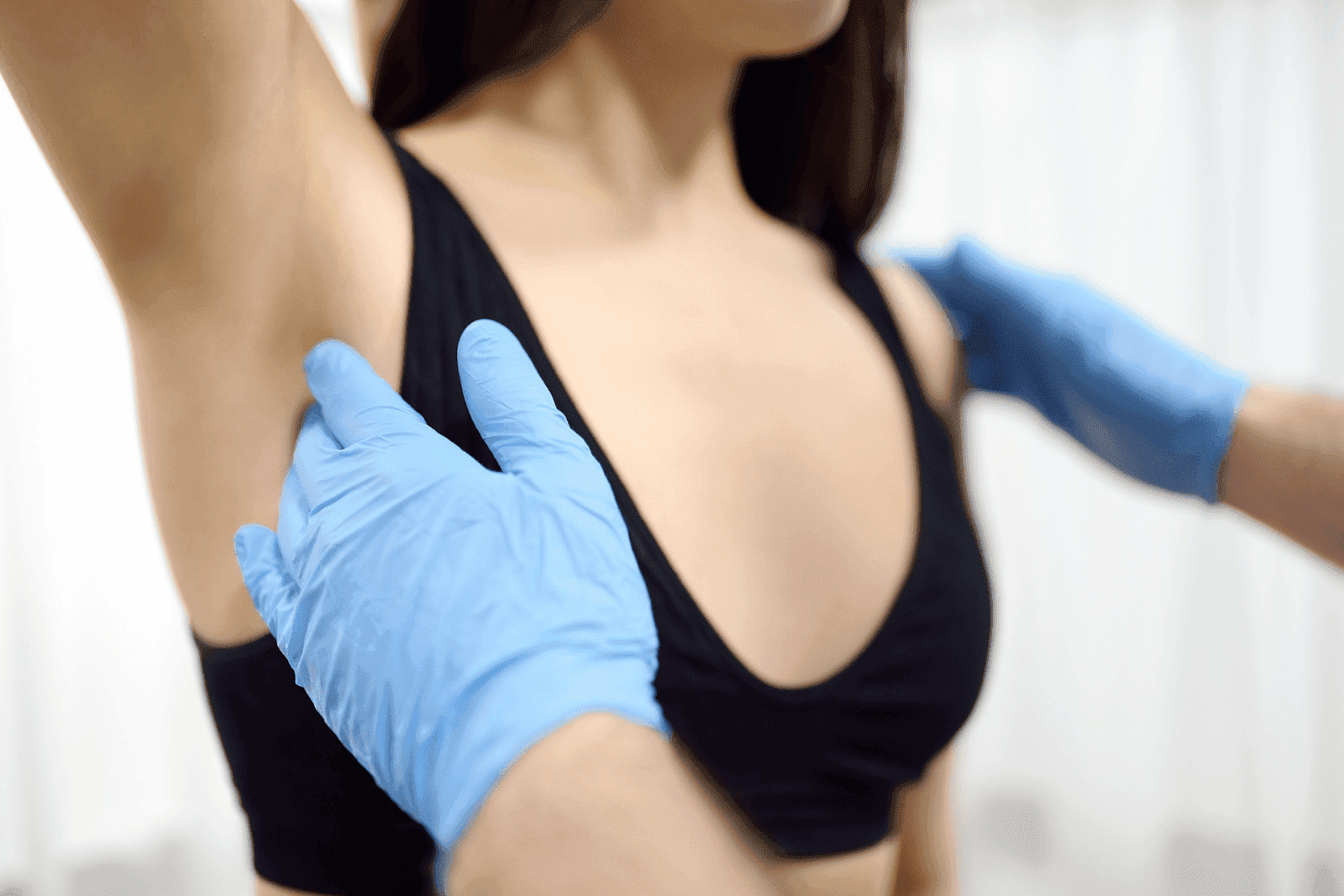Wondering If You Have a Thumb Injury? Here’s How to Check
Thumb injuries can be surprisingly common and often happen during everyday activities—from sports and gardening to simple slips or falls. Because the thumb plays a crucial [...]
Read More
Medically reviewed by Abhijit Bhattacharyya | MD, PhD, MBA, Tufts University School of Medicine - Miami, Florida on August 19th, 2025.
Feeling a new lump in the armpit can be alarming. Most of the time, these lumps are benign and related to infections or localized inflammation, but sometimes they can signal more serious conditions that require prompt evaluation. This article explains common causes, how to tell when a lump is worrisome, what tests clinicians use, everyday self-care, and when to seek in-person or telehealth care, including how Doctronic can help with fast, affordable evaluations.
A swollen lump in the armpit most often represents an enlarged lymph node, but several other structures live in that area. Lymph nodes filter lymphatic fluid and commonly swell when the body fights infection. The axilla also contains sweat glands, hair follicles, fatty tissue, small cysts, and blood vessels, any of which can produce a palpable lump.
Common causes include bacterial or viral infections, localized abscesses, inflamed hair follicles, benign cysts or lipomas, and reactive lymphadenopathy after vaccinations. Less commonly, lumps reflect systemic conditions such as tuberculosis, autoimmune disease, or cancers (for example, lymphoma or metastasis from nearby sites, including the breast).
 Typical Infectious Causes
Typical Infectious CausesBacterial skin infections (cellulitis), infected hair follicles, and pus-filled abscesses frequently cause painful, tender swelling in the armpit. Cat-scratch disease, caused by Bartonella henselae, is a classic cause of a tender, enlarged lymph node after an animal scratch. Viral illnesses such as mononucleosis or common respiratory infections can produce softer, mobile lymph node enlargement that often resolves with the viral illness.
Benign masses such as lipomas (soft fatty tumors) or epidermal inclusion cysts are generally painless and movable. Autoimmune disease and systemic infections like tuberculosis can lead to more persistent lymph node enlargement. Malignancies, including lymphoma or metastatic cancer from the breast or skin, are less common but important to consider when nodes are hard, fixed, growing progressively, or accompanied by other concerning symptoms.
Not every lump needs oncologic workup. Key details that change the level of concern include the lump’s size, consistency, tenderness, rate of growth, and associated symptoms. These characteristics help clinicians decide whether watchful waiting, bloodwork, imaging, or biopsy is appropriate.
Size greater than about 2 cm (roughly the size of a grape) or a lump that continues to grow.
A hard, firm, or fixed (non-mobile) mass, which does not slide under the skin when pushed.
Absence of pain (non-tender) in a node that continues to enlarge, especially in adults over 40.
Systemic symptoms such as unexplained fever, night sweats, significant unintentional weight loss, or persistent fatigue.
Redness, warmth, or fluctuance (a soft, wave-like feel suggesting pus) could indicate an abscess needing drainage.
Tender, soft, and mobile nodes that appear during or right after a local skin infection or a known viral illness.
Lumps that shrink back over a few weeks as the infection clears or after stopping a known irritant (for example, after changing deodorant or grooming habits).
Evaluation begins with a careful history and physical exam. Useful historical details include recent infections or skin injuries, recent vaccinations, travel history, animal exposures, and any history of cancer. The exam assesses size, texture, mobility, and whether other nodes in the neck, groin, or elsewhere are enlarged.
Blood tests: A complete blood count (CBC) can show signs of infection or hematologic disorders. Markers of inflammation, such as ESR or CRP, may be ordered in some cases.
Ultrasound: A safe, quick imaging test that helps distinguish cystic from solid masses and characterizes lymph nodes (shape, internal blood flow). It’s often the first imaging step for superficial lumps.
Mammography: For women, a lump in the axilla can sometimes be related to breast pathology; mammography and targeted breast ultrasound are considered if there are breast symptoms or risk factors.
CT or MRI: Used when deeper tissue assessment is needed or if there is concern for more extensive disease.
Biopsy: Fine needle aspiration (FNA) or core needle biopsy can obtain cells for diagnosis if cancer or atypical infection is suspected. An excisional biopsy (removing the entire node) might be recommended in some cases.
Treatment depends entirely on the underlying diagnosis. Many benign and infectious causes have straightforward treatments, while persistent or suspicious nodes require specialist referral and sometimes oncologic management.
Bacterial infections commonly respond to antibiotics and local wound care. Abscesses generally require incision and drainage performed by a clinician. For viral causes, supportive care (rest, fluids, pain relief) is often sufficient; the nodes tend to shrink as the virus resolves.
Reactive lymphadenopathy after vaccination or a minor skin irritation usually resolves without specific therapy over several weeks. If symptoms persist beyond 4–6 weeks, re-evaluation is appropriate.
Lipomas or epidermal inclusion cysts that are bothersome or growing may be removed in an outpatient procedure. Excision both treats the problem and provides a tissue diagnosis if needed.
If biopsy reveals lymphoma, metastatic disease, or another cancer, specialty care from oncology and possibly surgical teams will be coordinated. Treatment depends on the specific diagnosis and may include surgery, chemotherapy, radiation, or targeted therapies.
Most people can begin conservative measures at home while arranging medical evaluation. These steps can reduce discomfort and help monitor changes:
Warm compresses (10–15 minutes several times daily) can ease pain and encourage drainage with superficial infections.
Over-the-counter pain relievers such as acetaminophen or ibuprofen help manage discomfort and inflammation.
Keep the area clean and avoid squeezing, lance, or attempting to drain a lump at home, this risks spreading infection and creating scarring.
Note changes in size, pain, or skin appearance; photograph the lump periodically for comparison and bring photos to a clinical visit if travel or scheduling is delayed.
Some features require rapid in-person attention, often through urgent care or emergency services: severe, rapidly worsening pain; high fever with chills; spreading redness or streaking up the arm (lymphangitis); large, fluctuant abscesses causing severe discomfort; or signs of sepsis (confusion, very fast heart rate, difficulty breathing).
Doctronic does not maintain a list of urgent care locations or hours, but a telehealth assessment can help determine urgency and next steps. For immediate life-threatening symptoms, call emergency services.
Telehealth is especially useful when initial guidance is needed quickly. A telehealth clinician can review photos, take a detailed history, and decide whether home care is appropriate, an urgent in-person visit is needed, or further testing should be arranged. Doctronic offers both free AI-driven visits and inexpensive video visits with licensed clinicians 24/7 across all 50 states, often for less than $40.
Doctronic’s AI doctor can provide an initial, research-backed assessment in seconds, drawing on up-to-date peer-reviewed medical information. More than 10 million people have used the system, and many find the combination of fast AI guidance plus affordable human video visits especially helpful when monitoring lumps that may or may not require in-person evaluation. For many users, this model speeds appropriate care and reduces unnecessary travel to clinics or emergency rooms. Book a visit or try the AI assessment at Doctronic.ai.
During a telehealth visit, be prepared to describe the lump’s history (when it first appeared, changes in size, any associated symptoms), recent illnesses, vaccinations, animal exposures, and relevant medical history such as prior cancers or immunosuppression. Upload clear photos of the armpit from several angles and, if comfortable, video from different arm positions to help the clinician assess mobility and skin changes.
Clinicians focus on a few high-yield questions that guide testing and management:
When did you first notice the lump, and has it changed?
Is the lump painful, soft, hard, or mobile?
Any recent fevers, night sweats, weight loss, or fatigue?
Recent skin infections, insect or animal bites, or new shaving/grooming products?
Any history of cancer, especially breast cancer, lymphoma, or skin cancers?
These answers help determine whether immediate imaging, lab testing, or biopsy is needed, or whether observation is reasonable.
Not all lumps are preventable, but some measures reduce the risk of skin-related causes and local infections:
Maintain good skin hygiene of the armpit area and treat any minor cuts promptly with cleansing and a topical antibiotic when appropriate.
Use gentle shaving techniques and consider alternatives (electric razors or depilatory creams) if frequent folliculitis or ingrown hairs are a problem.
Promptly treat any known skin infections to reduce the chance of nearby lymph node involvement. Seek medical care for red wounds, spreading, or producing pus.
For those with recurring inflamed sweat glands (hidradenitis suppurativa), discuss preventive strategies and medical options with a clinician, since specialist management can reduce recurrent nodules and scarring.
Because axillary lymph nodes are common sites for breast cancer spread, any unexplained, persistent, hard, or non-tender armpit lump in adults, especially women, prompts consideration of breast imaging. This is particularly true for those with a family history of breast cancer, personal history of breast abnormalities, or concerning features on exam.
A mammogram or targeted breast ultrasound can usually clarify whether a breast lesion could be the source of axillary nodal enlargement. Doctronic’s telehealth clinicians can advise on whether breast imaging should be arranged promptly based on individual risk factors and exam findings.
Most armpit lumps are benign and related to infection or localized inflammation. Concerning signs include large size (>2 cm), firmness, fixation to surrounding tissue, progressive growth, and systemic symptoms like fever, night sweats, or unexplained weight loss. If any of those are present, prompt medical evaluation is warranted.
For non-urgent or early concerns, telehealth can be an excellent first step. Doctronic offers a free AI-driven visit for rapid guidance and affordable video visits with clinicians for follow-up, available 24/7 in all 50 states, often for under $40. For a quick, research-based assessment or to schedule a clinician visit, see Doctronic.ai.
 Final Practical Checklist
Final Practical ChecklistMonitor the lump for 2–4 weeks if it is small, tender, and appears linked to a recent infection. Use warm compresses and pain relievers.
Seek medical evaluation sooner if the lump is large, hard, fixed, steadily enlarging, or accompanied by systemic symptoms.
Use telehealth for fast guidance, image review, and to decide whether an urgent in-person evaluation, imaging, or biopsy is needed.
Discovering a lump in the armpit is understandably concerning, but timely, informed steps help determine whether this is a temporary issue or something needing more thorough investigation. Fast, accessible telehealth options can provide peace of mind and speed appropriate care toward the right setting.
If you're worried about a new or changing lump, get a rapid, research-backed assessment from Doctronic, the #1 AI Doctor, and decide whether urgent care, imaging, or watchful waiting is right for you. Our AI visit is free and available now, and if you want to speak with a clinician we offer convenient video visits 24/7 in all 50 states for under $40. More than 10 million people have used Doctronic to get faster, smarter, and more personal care. Skip the line. Talk to an AI Doctor Now, for free.
Thumb injuries can be surprisingly common and often happen during everyday activities—from sports and gardening to simple slips or falls. Because the thumb plays a crucial [...]
Read MoreAs the warmer months arrive, many people find themselves spending more time outdoors, enjoying parks, gardens, and open fields. However, for some, this seasonal joy comes [...]
Read MoreMany people enjoy ice cream as a delicious treat, especially on warm days or as a comforting dessert. However, some find that eating ice cream triggers an unexpected [...]
Read More